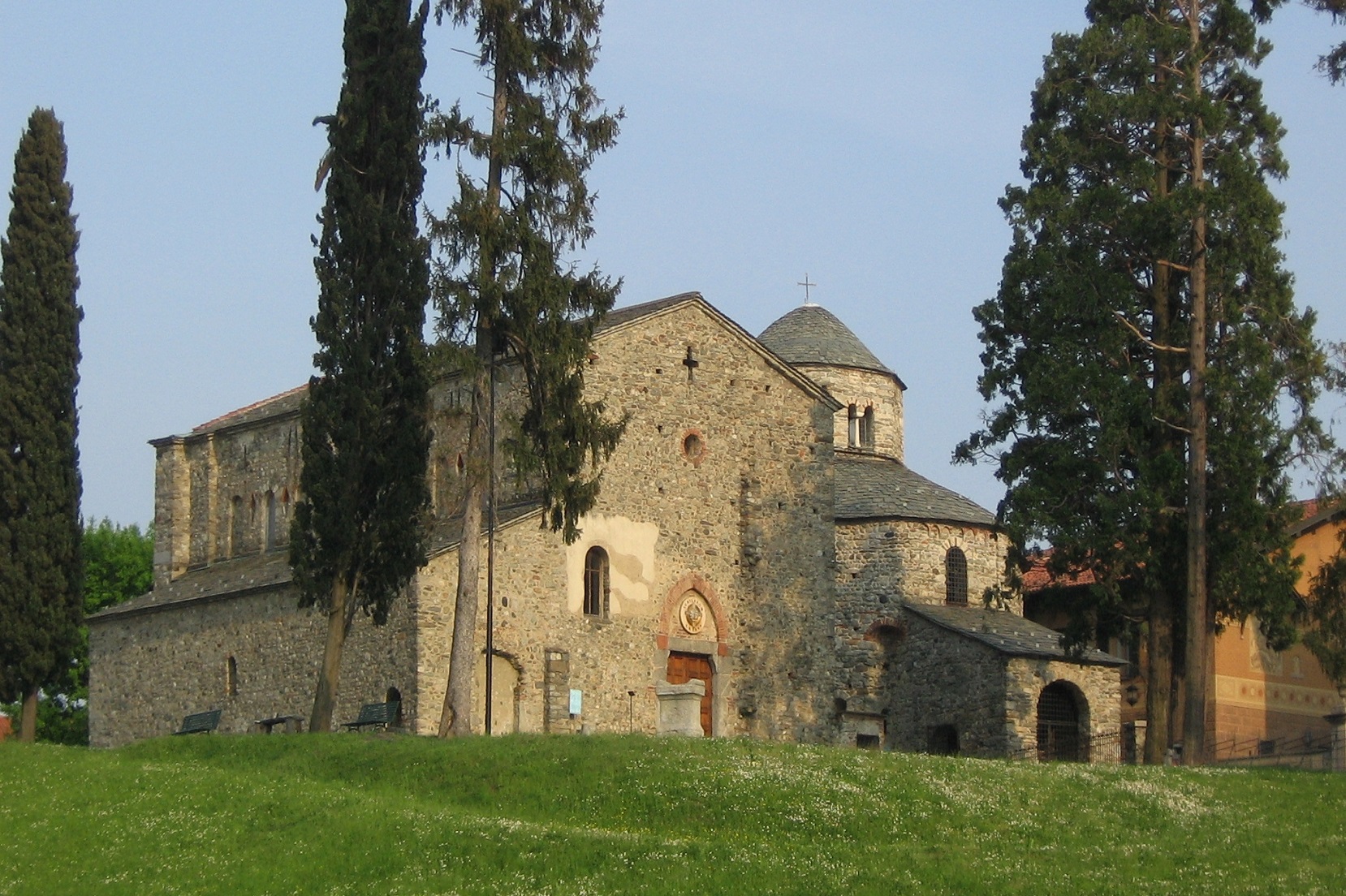Full of history and local memories, the Route of S. Pietro allows to admire evocative traces of the past in a strongly urbanized territory: historic farmhouses, precious sanctuaries, churches linked to ancient paths, elegant noble villas from the eighteenth and nineteenth centuries.
In its first part, the route overlaps the ancient Cantù-Seveso path along which in 1252, in a period of violent religious contrasts, Pietro da Verona, an inquisitor and Dominican preacher, was killed while he was walking from Como to the Basilica of S. Eustorgio in Milan.
The monumental complex of Galliano in Cantù (Co)
The monumental complex of Galliano includes the Basilica of San Vincenzo and the Baptistery of San Giovanni Battista. Located on top of a hill just outside Cantù, in Galliano, the basilica and the baptistery are a noteworthy example of Lombard Romanesque.
The Basilica, commissioned by the archbishop of Milan Ariberto da Intimiano, was the seat of the parish church of Cantù until the sixteenth century. Later it declined to ruin, until the first decades of the 20th century. Some parts, in particular the right aisle and the covered passage that connected the basilica to the baptistery, have not been rebuilt.
The interior has beautiful frescoes, that were mostly made when the church was built or slightly after; they are the largest and still preserved of that period throughout northern Italy.
The baptistery of San Giovanni was built at the beginning of the eleventh century. The lower floor was specifically designed for the rite of baptism, with a large circular basin in the middle; on the upper floor there are traces of three masonry altars. In the outdoor area there is a tactile model reproducing the monumental complex with embossed Braille printing indications.
The entrance to the Basilica and the Baptistery is free.
For information and to reserve guided tours, please contact:
Pro Cantù tel. +39 031 716094 mail: procantu@cracantu.it
For information on accessibility of the Complex of Galliano, please click on this link
Oratory of S. Stefano in Lentate sul Seveso (MB)
From Cantù you can drive to Seveso, with a small detour towards the centre of Lentate to reach its splendid Oratory of S. Stefano. Built around 1369, commissioned by the noble Stefano Porro, a diplomat at the court of Bernabò and Galeazzo Visconti and diplomat in Boemia at the court of Charles IV, the Oratory of S. Stefano is of considerable interest for the cycle of frescoes preserved inside it and made by several artists of the time. The themes represented are partly linked to the history of the Porro's family and partly to the Christian iconographic tradition.
The oratory is divided into two well-defined areas: a rectangular hall reserved for the faithful and a raised quadrangular presbytery, covered by a cross vault. These two spaces are connected by a triumphal arch, on which it is possible to admire a wonderful Last Judgment, in which you can recognize the typical features of Lombard painting.
For more information on the Oratory and how to visit it, please click this link
Here you can find information on accessibility.
The Sanctuary of San Pietro Martire in Seveso (MB)
At 5 km from the Oratory of Santo Stefano, in Seveso, you can visit the Sanctuary built by the Umiliati monks in the 1300s, together with a guest house for pilgrims, in memory of the martyrdom of San Pietro da Verona, which took place in 1252, whose relics are in the crypt. In the side chapels of the church there are valuable frescoes; the church contains works by some of the leading artists of Milan of the second half of the 1600s. From a side aisle of the church you can reach the cloister where many events are organized.
Here you can find information on accessibility.
From Seveso the route continues to Milan along the ancient Comasinella, passing through elegant seventeenth-nineteenth-century noble villas. The route then enters Milan and here the first stop is precisely at its symbol: the Duomo (the cathedral).
The "Duomo" of Milan
The Cathedral of Milan, dedicated to Santa Maria Nascente and better known as "the Duomo", is the timeless symbol of Milan and is considered the third Catholic church in the world after San Pietro in the Vatican State and the cathedral of Seville. With its 157 meters in length, a surface of 11,700 square meters and its 135 spiers, the highest of which is slightly more than 108 meters, the cathedral is the largest and most complex Gothic building in Italy and looks like a real triumph of pinnacles, spiers, buttresses, flying buttresses, marvellous windows.
In the chapel of S. Carlo Borromeo, designed by Francesco Maria Ricchino in 1606, the rock crystal urn that contains the body of the saint in his pontifical dress is preserved.
From the terraces, which can be accessed by elevator or stairs, you can admire the whole city of Milan.
Started in 1386 by Gian Galeazzo Visconti, the cathedral was built over five centuries and underwent many changes over time.
Between the seventeenth and eighteenth centuries, the tiburium was completed with the great spire and the Madonnina, the most famous symbol of Milan. The statue is 4.16 meters tall and was installed in October 1774 on the highest spire. In the nineteenth century the facade was completed.
The architecture, the art, the history of the cathedral is so rich that they require some time available and information to be appreciated at best. People with disabilities and their carers can use free audio-guides, with a Braille keyboard, and radio guides.
Thanks to "Ad Artem" association, during the visit deaf people have the possibility to ask the help of a deaf signer guide (no LIS interpreter). The collaboration with "Arte Insieme" allows blind people and people with visual impairment to book a tactile visit to discover a selection of works from the collection.
At this link you can find information on the accessibility of the Cathedral, of the Early Christian Baptistery of San Giovanni and of the Terraces.
Church of San Sepolcro
A few hundred meters from the Cathedral you can visit the Church of San Sepolcro, which stands in the place where, in Roman times, there was the Roman forum, at the cardo and decumanus crossing. The church was built on two levels and its foundation, in 1030, was due to Benedetto Rozo, a citizen who probably was a master of the Milanese Mint.
The dedication to San Sepolcro came later and is linked to the Crusades: it dates back to 1100 when the Archbishop of Milan, Anselm IV from Bovisio, celebrated the anniversary of the Lombard expedition to the Holy Land. The church was then significantly remodelled to make it look like the Holy Sepulcher of Jerusalem, but over the centuries it underwent numerous remaking. The Crypt, recalled in some drawings by Leonardo da Vinci, is covered with marble slabs of the Augustan age that come from the ancient Roman Forum paving and preserves some frescoes, the beautiful sarcophagus of 1300 by the Campionese school containing some relics of the Holy Land and a group in terracotta by Agostino de Fondulis.
Church of San Giorgio al Palazzo
In via Torino, overlooking a small square, there is the church of San Giorgio al Palazzo. Built during the eighth century, during the Lombard period, it was then rebuilt in the eleventh century and rededicated by the bishop Anselm V in 1129. The construction of the high bell tower dates back to this period, where, according to tradition, in 1164 the precious relics of the Magi were hidden, brought here by Sant'Eustorgio to avoid that Barbarossa might steal them.
Starting from the 16th century and for the following three centuries, the building was affected by a series of interventions that modified its original appearance: at first some side chapels were built, including the Cappella della Passione, frescoed in 1516 by Bernardino Luini; then, the provisions issued during the pastoral visits of San Carlo Borromeo involved a reorganization of the internal organization according to the principles of the Counter-Reformation and in 1623 the Church was renovated in Baroque style on a project by Francesco Maria Richini.
The six chapels are worth a visit and they can be visited without barriers. They host important works of art, including the beautiful cycle of frescoes of the "Cappella della Passione" by Bernardino Luini.
Here you can find all the information on accessibility.
Crossing the Parco delle Basiliche and continuing to walk in the heart of the imperial, early Christian and Christian Roman city, at the end of the path you reach the Basilica of Sant'Eustorgio.
Basilica of Sant'Eustorgio
Founded in the fourth century and rebuilt in the nineteenth century, the Basilica of Sant'Eustorgio is one of the most ancient churches in Milan. It was probably founded by Eustorgio I, bishop of Milan (344-350 AD). The church was built on a cemetery area dating back to the III-IV century AD, and, according to tradition, where the apostle Barnabas baptized the first Christians. Inside you can admire a cycle of frescoes by Vincenzo Foppa, who was the person in charge for the conception and direction of the pictorial decoration of the Basilica, that took place between 1464 and 1468.
The remains of a first church, from the early Christian era (sixth century), are still visible under the apse. At this link, you can watch a video presentation of the Cappella Portinari, one of the most complete and best preserved examples of Lombard Renaissance built at the time of Francesco Sforza. In the chapel it is possible to admire the Arca di San Pietro Martire, a Gothic sculpture by Giovanni di Balduccio in white Carrara marble made in 1339.
Here you can find information on accessibility.
Before leaving
More information on the route can be found on the site of the network of paths
On the portal dedicated to the Route you can find updated news and download route maps. http://www.camminosanpietro.it/
"Project carried out under the General program of intervention of the Lombardy Region, funded by the Ministry of Economic Development - 2015 Allocation".

